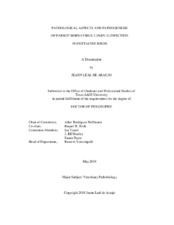| dc.contributor.advisor | Rodrigues Hoffmann, Aline | |
| dc.contributor.advisor | Rech, Raquel R | |
| dc.creator | Leal De Araujo, Jeann | |
| dc.date.accessioned | 2019-01-17T16:58:05Z | |
| dc.date.available | 2020-05-01T06:24:55Z | |
| dc.date.created | 2018-05 | |
| dc.date.issued | 2018-04-02 | |
| dc.date.submitted | May 2018 | |
| dc.identifier.uri | https://hdl.handle.net/1969.1/173366 | |
| dc.description.abstract | Parrot bornaviruses (PaBVs) are RNA viruses of the Bornaviridae family and the causative agents of proventricular dilatation disease (PDD).
PDD has many aspects that remain to be elucidated, including the mechanisms involved in its pathogenesis. The purpose of this work was to investigate different hypotheses linked to the pathogenesis of Parrot bornavirus 2 (PaBV-2) infection in psittacine birds.
We first tested the hypothesis of antibodies against gangliosides being involved in the development of PDD in psittacine birds. We analyzed the relationship between the presence of antiganglioside antibodies and microscopic lesions related to PDD in birds. No association between the presence of anti-ganglioside antibodies and the development of lesions resembling PDD was observed in our study, which corroborates with the hypothesis that PDD is not an auto-immune disease as previously speculated.
Second, we analyzed the progression of viral antigen and inflammatory lesions after the intramuscular inoculation of PaBV-2 in cockatiels. Histopathological, immunohistochemical and molecular analyses were performed in tissues of cockatiels in a chronological fashion. PaBV-2 was first detected in leukocytes in the inoculation site and adjacent nerves, then reached the brachial plexus, centripetally spread to the thoracic segment of the spinal cord, and subsequently invaded the other spinal segments and brain. PaBV-2 then centrifugally spread out of the central nervous system (CNS) to peripheral ganglia. Our results demonstrate that PaBV-2 first targets the CNS, before migrating to peripheral tissues such as the GI system.
Finally, we aimed to evaluate the distribution of inflammatory foci and viral antigen throughout 4 selected levels of brain and 3 segments of spinal cord in cockatiels experimentally infected with PaBV-2. Immunolabeling was first observed in the ventral horns of the thoracic spinal cord. Inflammatory lesions were first identified in the gray matter of the thalamus and brainstem. Encephalitis was more severe in the thalamus and brainstem, while myelitis was equally distributed between all segments of the spinal cord. Our results demonstrate a caudal-rostral viral distribution of PABV-2.
Our results reemphasize the role of PaBVs as the causative agents of PDD; the lack of an autoimmune component; and the detection of PaBV-2 in the CNS before peripheral organs. | en |
| dc.format.mimetype | application/pdf | |
| dc.language.iso | en | |
| dc.subject | Proventricular dilatation disease | en |
| dc.subject | ganglioneuritis | en |
| dc.subject | encephalitis | en |
| dc.subject | immunohistochemistry | en |
| dc.subject | pathology | en |
| dc.title | Pathological Aspects and Pathogenesis of Parrot Bornavirus 2 (PaBV-2) Infection in Psittacine Birds | en |
| dc.type | Thesis | en |
| thesis.degree.department | Veterinary Pathobiology | en |
| thesis.degree.discipline | Veterinary Pathobiology | en |
| thesis.degree.grantor | Texas A & M University | en |
| thesis.degree.name | Doctor of Philosophy | en |
| thesis.degree.level | Doctoral | en |
| dc.contributor.committeeMember | Heatley, J. Jill | |
| dc.contributor.committeeMember | Payne, Susan | |
| dc.contributor.committeeMember | Tizard, Ian | |
| dc.type.material | text | en |
| dc.date.updated | 2019-01-17T16:58:06Z | |
| local.embargo.terms | 2020-05-01 | |
| local.etdauthor.orcid | 0000-0002-2493-3062 | |


